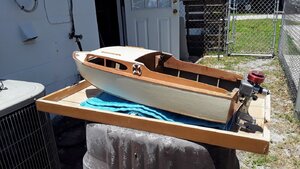This story is more about not giving up, (even if it takes a long time to come back to), when at first you don't succeeded try try again!!
The model though special to me is nothing special in it self.
It all starts about 40 years ago at about the age of 16 and after building many plastic kits and a couple of rough balsa scratch built jobs, my father encouraged me to scratch build a model, Dad thought that Piranha, one of the free Model Maker plans Dad had in his collection, drawn by Vic Smeed was a good starting point. On this plan was a simplified hull or a more complex version, the simplified hull was selected.
Material was then purchased from Perfectus Air Screws in Newport, Melbourne some aircraft quality ply and spruce (probably a little over the top for the project at hand!).
Construction began, being quite standard cut frames with keel and stringers I won’t go into detail about that, all glued together with 24 hour araldite (messy stuff when I was young) a homemade prop shaft which was to cause problems later, the hull was then sealed with a large amount of polyester resin inside and out, an unforseen side effect of this was to unfortunately add a large amount of weight to the boat and not much strength something that had not occurred to me at the time, at the time I thought it made a stronger boat, clearly I had a lot to learn.
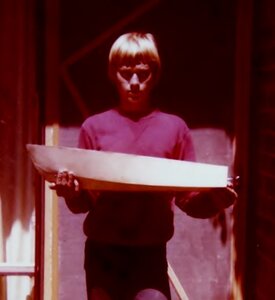
After painting in automotive undercoat, fitting a Johnson brushed motor turning a plastic Groupner 3 bladed prop through a spring coupling, control for motor was through a 10Amp 12Volt electronic speed controller, energy was supplied using 10 domestic ni-cad cells, the latest thing in 1980 and quite an expensive bit of kit, especially when my only source of income was a paper round!
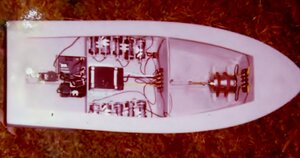
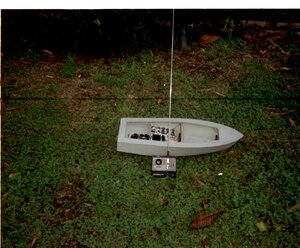
All good to go, bench tested, finally the big day had come around so dad took my boat and I to the nearest body of water with great anticipation, my boat was placed in the water then gradually moving the throttle stick on my 3 channel AM Sanwa controller until it was fully forward, to my horror the expected high speed boat produced little more than a gentle bow wave with a fair bit of noise from the prop shaft, to say I was disappointed would be an understatement! My high speed boat went no faster than crawling speed no danger to the swans pictured below, and then on its second run the batteries were fried!
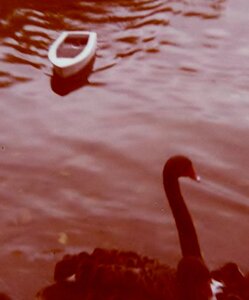
Ok so I had no idea about discharge rates of batteries, one of many things that I was to learn over the years, my next attempt after several years was to purchase a 7.2Volt 700milliamp pack of high discharge ni-cad’s this discovered the next problem, the 10Amp speed controller over heated and died, also the spring type coupling couldn’t cope with the extra power and the noise coming from my prop shaft was not nice, due in part to the thin walled housing and small diameter yet long shaft, together with no support at either end, this problem was partly solved by adding a skeg that supports the rear end and a bush half way along the shaft. A new electronic speed controller was purchased this worked for a while until it too let the smoke out! At that point I was bitterly disappointed and I had lost all faith in fancy electronic speed controllers.
Another couple of years would pass then I decided to move away from expensive electronic speed controllers and installed a mechanical Tamiya style 3 forward and 3 reverse speed control although the 5 minute run time on ni-cad’s wasn’t long enough and performance was still nowhere near what I hoped for, so a 12Volt gel cell (a very heavy battery) was installed I didn’t want to install 2 X 7.2Volt packs in series as that would give 14.4 volts 2.4 volts more than the maximum of 12 volts recommended for the motor , (I didn’t know DC brushed motors can handle a slightly higher voltage than recommended as long as the extra heat can be removed)my hope was that 12Volts would help move things along, which it did have a reasonable turn of speed at 12 volts, trouble is it over heated the motor which then seized and with a lot of stored energy left in the battery caused over heating of resistor on the speed controller which in turn burnt a hole through a deck that formed a water tight compartment, to add insult to injury the boat was now stranded in amongst prickly bushes at the water’s edge, a hasty recovery ensued , then after receiving many scratches and abrasions I managed to retrieve my boat.
It was back to the drawing board, I didn’t know what to do with my labour of love, so I took it to a hobby shop in Ringwood, the guy there told me to take it to someone that was nearby who raced boats, the advice I got from the guy I met was to try a gear reduction, this would reduce the shaft RPM thereby reducing whip in the shaft, (a why didn’t I think of that moment!!!) I thought that this was good advice and worth trying.
So I got to work and removed the existing motor mount and made a new mount and supports out of aluminium while installing the new mount I supported the shaft housing at the motor end. The motor mount was fabricated out of aluminium tube with brackets soldered on each side then the tube was machined with a land each end for “O” rings to hold the motor in place and provide a seal to possibly add water cooling, Tamiya RC buggy gears were purchased a ratio of approximately 3:1 being selected, new 2 bladed props of various sizes from Full Ahead were also purchased. During this refit the burnt hole was plugged a fan added to the speed controller then the fan and a heat sink were mounted on a plate so there was no contact between things that get very hot and things that can burn! An adjustable battery mount was made from Aluminium, also the inside was repainted and now having a second pack of NiCad batteries wired in series the 2 packs gave me 14.2 volts all good to go!
Spurred on with renewed hope I resumed building, the original plans had a cabin that I didn’t like the look of so I decided to change it, looking through Dads old Model Maker magazines I came across plans for a Fairy Huntsman, the shape of this cabin appealed to me so I drew a cabin that was similar in appearance and made it using 1/8th ply formers with spruce stringers and skinned in 1/16th ply. A former was made from tinplate to form a piece of Perspex in the shape of a windscreen, the Perspex was heated in an oven to a temperature that made it quite soft, then quickly bent over the former. Cabin window frames were cut from sheet styrene using metal templates. A pulpit rail was fabricated from bronze welding rod and carefully bent to shape uprights being silver soldered on, then chrome plated along with other fittings made from brass. The cabin and hull were then painted using automotive paint, many coats being applied sanding down between coats until a glassy finish was achieved. Cabin windows and windscreen were tinted using Tamiya smoke clear paint.
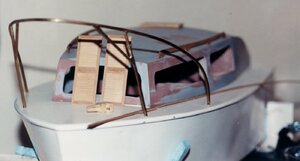
Back to the pond with great anticipation, at last performance that was getting close to what I was looking for, the next issue was radio interference caused by the DC motors brushes arcing, also using an AM radio didn’t help, what made it worse was the fact that my receiver aerial looped around inside the boat, things remained like this for a few years.
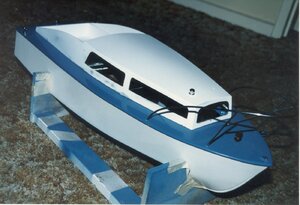
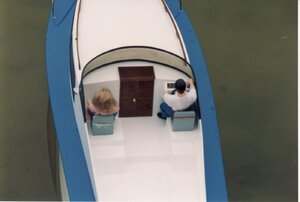

Then after trying different capacitors across the brushes to help reduce interference with very little improvement, around this time I started occasionally going to Box Hill Model Boat Club and after receiving advice from several people, I bit the bullet and made a mast, then pocked the aerial up through the mast to the outside this made a large improvement.
After a few years use the motor gave up and was replaced with another brushed motor of higher performance, this motor wouldn’t fit into my fabricated aluminium housing and a modification was made to the mount, the new mount being easy to adjust clearance between the gears, new capacitors, copper tubing wrapped around the motor for water cooling, also brush cooling was fitted, after a visit to Float a Boat a new water cooled electronic speed controller was purchased and installed, also a new prop was ordered from the Prop Shop then installed, another visit to Box hill to test the new setup which worked well, however the boat seemed to push a large amount of water out of the way and never planned at this point it was suggested that spray rails be fitted to the hull, this made sense to me(another why didn’t I think of that moment!!) so off home for another modification.
Back to the water, wow what a difference the spray rails made my boat plained for the first time!
So I had got the performance that I always wanted and it only took 25 years to get there!!
A few more years passed and looking for a model boat club/group that was closer to home I stumbled across the Broadmeadows Model Boat Group, after I joined the group the boat got a lot more use than it had previously ever had. The next and latest upgrade was to bring the technology into this century by replacing the AM radio and brushed motor with a 2.4 GHz unit also a brushless outrunner motor with controller, all installed no problem, testing revealed I now had more power than needed for the first time!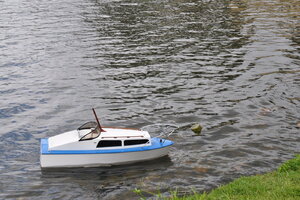
So even after all this time I cannot say that the boat is finished as there is no crew yet, also the hull needs repainting again and a new stand would be nice, then again are models ever really finished.
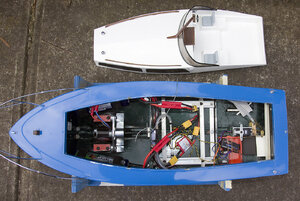
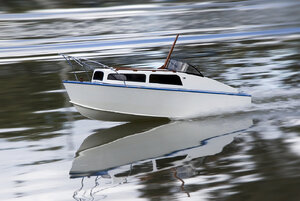
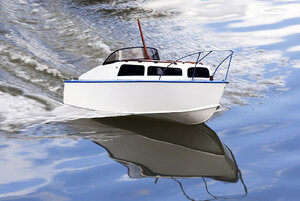
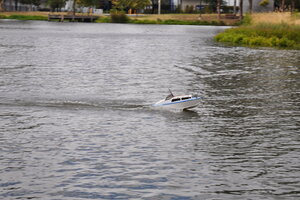
The model though special to me is nothing special in it self.
It all starts about 40 years ago at about the age of 16 and after building many plastic kits and a couple of rough balsa scratch built jobs, my father encouraged me to scratch build a model, Dad thought that Piranha, one of the free Model Maker plans Dad had in his collection, drawn by Vic Smeed was a good starting point. On this plan was a simplified hull or a more complex version, the simplified hull was selected.
Material was then purchased from Perfectus Air Screws in Newport, Melbourne some aircraft quality ply and spruce (probably a little over the top for the project at hand!).
Construction began, being quite standard cut frames with keel and stringers I won’t go into detail about that, all glued together with 24 hour araldite (messy stuff when I was young) a homemade prop shaft which was to cause problems later, the hull was then sealed with a large amount of polyester resin inside and out, an unforseen side effect of this was to unfortunately add a large amount of weight to the boat and not much strength something that had not occurred to me at the time, at the time I thought it made a stronger boat, clearly I had a lot to learn.

After painting in automotive undercoat, fitting a Johnson brushed motor turning a plastic Groupner 3 bladed prop through a spring coupling, control for motor was through a 10Amp 12Volt electronic speed controller, energy was supplied using 10 domestic ni-cad cells, the latest thing in 1980 and quite an expensive bit of kit, especially when my only source of income was a paper round!


All good to go, bench tested, finally the big day had come around so dad took my boat and I to the nearest body of water with great anticipation, my boat was placed in the water then gradually moving the throttle stick on my 3 channel AM Sanwa controller until it was fully forward, to my horror the expected high speed boat produced little more than a gentle bow wave with a fair bit of noise from the prop shaft, to say I was disappointed would be an understatement! My high speed boat went no faster than crawling speed no danger to the swans pictured below, and then on its second run the batteries were fried!

Ok so I had no idea about discharge rates of batteries, one of many things that I was to learn over the years, my next attempt after several years was to purchase a 7.2Volt 700milliamp pack of high discharge ni-cad’s this discovered the next problem, the 10Amp speed controller over heated and died, also the spring type coupling couldn’t cope with the extra power and the noise coming from my prop shaft was not nice, due in part to the thin walled housing and small diameter yet long shaft, together with no support at either end, this problem was partly solved by adding a skeg that supports the rear end and a bush half way along the shaft. A new electronic speed controller was purchased this worked for a while until it too let the smoke out! At that point I was bitterly disappointed and I had lost all faith in fancy electronic speed controllers.
Another couple of years would pass then I decided to move away from expensive electronic speed controllers and installed a mechanical Tamiya style 3 forward and 3 reverse speed control although the 5 minute run time on ni-cad’s wasn’t long enough and performance was still nowhere near what I hoped for, so a 12Volt gel cell (a very heavy battery) was installed I didn’t want to install 2 X 7.2Volt packs in series as that would give 14.4 volts 2.4 volts more than the maximum of 12 volts recommended for the motor , (I didn’t know DC brushed motors can handle a slightly higher voltage than recommended as long as the extra heat can be removed)my hope was that 12Volts would help move things along, which it did have a reasonable turn of speed at 12 volts, trouble is it over heated the motor which then seized and with a lot of stored energy left in the battery caused over heating of resistor on the speed controller which in turn burnt a hole through a deck that formed a water tight compartment, to add insult to injury the boat was now stranded in amongst prickly bushes at the water’s edge, a hasty recovery ensued , then after receiving many scratches and abrasions I managed to retrieve my boat.
It was back to the drawing board, I didn’t know what to do with my labour of love, so I took it to a hobby shop in Ringwood, the guy there told me to take it to someone that was nearby who raced boats, the advice I got from the guy I met was to try a gear reduction, this would reduce the shaft RPM thereby reducing whip in the shaft, (a why didn’t I think of that moment!!!) I thought that this was good advice and worth trying.
So I got to work and removed the existing motor mount and made a new mount and supports out of aluminium while installing the new mount I supported the shaft housing at the motor end. The motor mount was fabricated out of aluminium tube with brackets soldered on each side then the tube was machined with a land each end for “O” rings to hold the motor in place and provide a seal to possibly add water cooling, Tamiya RC buggy gears were purchased a ratio of approximately 3:1 being selected, new 2 bladed props of various sizes from Full Ahead were also purchased. During this refit the burnt hole was plugged a fan added to the speed controller then the fan and a heat sink were mounted on a plate so there was no contact between things that get very hot and things that can burn! An adjustable battery mount was made from Aluminium, also the inside was repainted and now having a second pack of NiCad batteries wired in series the 2 packs gave me 14.2 volts all good to go!
Spurred on with renewed hope I resumed building, the original plans had a cabin that I didn’t like the look of so I decided to change it, looking through Dads old Model Maker magazines I came across plans for a Fairy Huntsman, the shape of this cabin appealed to me so I drew a cabin that was similar in appearance and made it using 1/8th ply formers with spruce stringers and skinned in 1/16th ply. A former was made from tinplate to form a piece of Perspex in the shape of a windscreen, the Perspex was heated in an oven to a temperature that made it quite soft, then quickly bent over the former. Cabin window frames were cut from sheet styrene using metal templates. A pulpit rail was fabricated from bronze welding rod and carefully bent to shape uprights being silver soldered on, then chrome plated along with other fittings made from brass. The cabin and hull were then painted using automotive paint, many coats being applied sanding down between coats until a glassy finish was achieved. Cabin windows and windscreen were tinted using Tamiya smoke clear paint.

Back to the pond with great anticipation, at last performance that was getting close to what I was looking for, the next issue was radio interference caused by the DC motors brushes arcing, also using an AM radio didn’t help, what made it worse was the fact that my receiver aerial looped around inside the boat, things remained like this for a few years.



Then after trying different capacitors across the brushes to help reduce interference with very little improvement, around this time I started occasionally going to Box Hill Model Boat Club and after receiving advice from several people, I bit the bullet and made a mast, then pocked the aerial up through the mast to the outside this made a large improvement.
After a few years use the motor gave up and was replaced with another brushed motor of higher performance, this motor wouldn’t fit into my fabricated aluminium housing and a modification was made to the mount, the new mount being easy to adjust clearance between the gears, new capacitors, copper tubing wrapped around the motor for water cooling, also brush cooling was fitted, after a visit to Float a Boat a new water cooled electronic speed controller was purchased and installed, also a new prop was ordered from the Prop Shop then installed, another visit to Box hill to test the new setup which worked well, however the boat seemed to push a large amount of water out of the way and never planned at this point it was suggested that spray rails be fitted to the hull, this made sense to me(another why didn’t I think of that moment!!) so off home for another modification.
Back to the water, wow what a difference the spray rails made my boat plained for the first time!
So I had got the performance that I always wanted and it only took 25 years to get there!!
A few more years passed and looking for a model boat club/group that was closer to home I stumbled across the Broadmeadows Model Boat Group, after I joined the group the boat got a lot more use than it had previously ever had. The next and latest upgrade was to bring the technology into this century by replacing the AM radio and brushed motor with a 2.4 GHz unit also a brushless outrunner motor with controller, all installed no problem, testing revealed I now had more power than needed for the first time!

So even after all this time I cannot say that the boat is finished as there is no crew yet, also the hull needs repainting again and a new stand would be nice, then again are models ever really finished.









